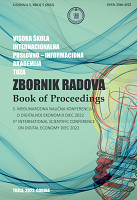DIAGNOSTIC INFORMATION SYSTEM IN HEALTH CARE INSTITUTIONS
DIAGNOSTIC INFORMATION SYSTEM IN HEALTH CARE INSTITUTIONS
Author(s): Ines IsakovićSubject(s): Business Economy / Management, Health and medicine and law, ICT Information and Communications Technologies
Published by: Internacionalna poslovno – informaciona akademija
Keywords: Laboratory Information Systems (LIS); Radiological Information System (RIS); Family Medicine Information System; Electronic Medical Record (EMR);
Summary/Abstract: The purpose of writing this scientific paper is to point out the necessity of introducing dedicated information systems due to the changes in the character of business processes and to enable a faster way of working within health care institutions. This paper aims to point out the advantages of diagnostic information systems. The development of information systems in health care led to the integration of different modules into a single IT unit that would join all the functions of the hospital information system. Consequently, we have different types of laboratories in health institutions, and some of them are biochemical, haematological, microbiological, histopathological, and genetic research laboratories, as well as modules in radiology and family medicine, and for these reasons, we adopt information systems to their needs. The function of all laboratories is to analyse samples and, based on the analysis, provide information on the characteristics of those samples. Today, we have a large number of samples that we need to analyse, and for these reasons, information systems are being introduced because it is impossible to work with so much data without automating the analysis process. With the introduction of radiological information systems, we are computerizing and modernizing the work of the radiological centre and the transition from paper and film to fully electronic business and digital recordings. This way of doing business allows us to have available radiological data in the right place at the right time. Within the radiological information systems, we will also mention standards such as DICOM (Digital Imaging and Communications in Medicine), PACS (Picture Archiving and Communication System), and HL7 (Health Level Seven). Family medicine represents a different approach to primary health care through an orientation towards continuous preservation and improvement of the health of the population, with the patient at the centre of care. To improve population health care, we must improve the work of health professionals so that these information systems do not represent a burden on work but enable automation of business processes, such as the Electronic Medical Record (EMR). At the end of the paper, we will write a summary of all the advantages of introducing information systems within a health institution
Journal: Zbornik radova Međunarodne naučne konferencije o digitalnoj ekonomiji DIEC
- Issue Year: 5/2022
- Issue No: 5
- Page Range: 143-153
- Page Count: 11
- Language: English

